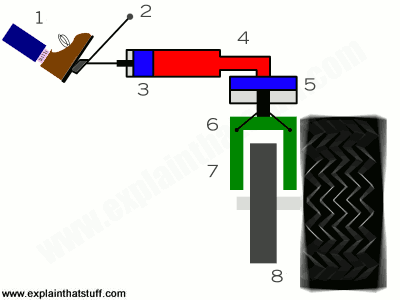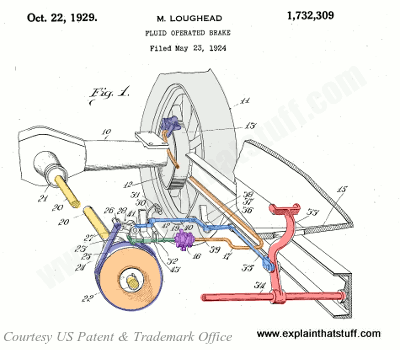
Brakes
by Chris Woodford. Last updated: April 25, 2023.
You're driving along quite happily when, all of a sudden, a dog runs out into the road just in front of you. You have a split second to react to what's happened. When you stamp on the brakes, you confidently expect they'll bring you to a halt in time. How can you be so sure? Because brakes use the power of science and thankfully, for the most part, science doesn't let us down!
Photo: Cars normally brake in a very controlled way using disc and drum brakes fitted just inside their wheels. If you brake really hard, the brakes and wheels can lock up. If the car still has enough momentum, it keeps on going and the locked tires act as brakes by rubbing against the road. Needless to say, you're not meant to brake like this except in emergencies—unless you want to replace your tires every few weeks! Photo by Amber Blanchard courtesy of US Marine Corps.
Sponsored links
Contents
The science of stopping
If you're moving, you have energy—kinetic energy to be precise. Kinetic energy is simply the energy an object possesses because it has both mass and velocity (speed in a certain direction). The more mass you have (effectively, the heavier you are) and the faster you're going, the more kinetic energy you have.
That's all well and good, but what if you suddenly need to stop? To change from moving quickly to not moving at all, you have to get rid of your kinetic energy.
If you're jumping from an airplane, the best way to lose energy is with a parachute. This giant sack of fabric drags behind you, slowing you down, reducing your velocity, and therefore helping to get rid of your kinetic energy. That means you can land safely. Drag-racing cars and land speed record cars also use parachutes to stop but, in practice, most vehicles simply use brakes.

Chart: The faster you go, the more kinetic energy you have and the harder your brakes will have to work to stop you.
Different brakes for different machines
From cars and trucks to planes and trains, brakes work in a similar way on most different vehicles. There are even brakes in wind turbines! Here's a quick comparison of some common brake systems.
Bicycle
If you ride a bicycle, you know all about brakes. If you want to stop suddenly, you squeeze the brake levers on the handlebars. Thin metal cables running to the back and front wheels pull on small calipers, forcing thick rubber blocks to press against the wheels. As they do so, friction between the blocks and the metal wheel rims generates heat, reducing your kinetic energy, and bringing you safely to a stop.
Although many bicycles still use caliper brakes, some use disc or drum brakes instead (described below).

Motorcycle
Motorcycles typically have disc brakes comprising a rotor and a brake pad. The rotor is a disc with holes (or slots) in it mounted on the side of the wheel. A brake pad, operated by a hydraulic cable, jams against the rotor to slow it down by friction. The holes in the rotor help to dissipate the heat generated.

Steam locomotive
The brakes on a steam locomotive work the same way as a car's and are even more obvious. You can see the brake just behind the wheel in this photo. It clamps against the locomotive's driving wheels to slow them down. Since there are no tires on the wheels, the friction that stops the train comes from the immense weight of the locomotive pressing the metal wheels down onto the track.

Airplane
Airplanes have brakes inside their wheels to help bring them to a stop on the runway, but they can also use air brakes to increase drag (air resistance) and slow themselves down—a bit like parachutes. Jet fighters often have a speed brake, which is a large metal plate just behind the cockpit that can be hydraulically raised to increase drag and braking.
Photo by Vincent Parker, US Air Force.

Wheelchair
Wheelchairs have brakes controlled from their handlebars, which pull on metal cables in a similar way to bike brakes. Unlike bikes, wheelchairs brake by clamping a piece of metal down onto the top of the tire tread so the wheels can't rotate. If you push the brake handle down, a lever locks the metal onto the tread so the chair can be safely parked; pull the handle up and the brake presses lightly against the tread, slowing the chair down as you push. Unfortunately, this tends to wear the tread, it's very noisy, and it's not very effective.

Wind turbine
Wind turbines have brakes to stop their rotors (propellers) turning too quickly. The brake is mounted inside the nacelle (the square-shaped casing behind the propeller that contains the gearbox and generator). Most turbines have an anemometer on them to measure the wind-speed. If the wind rises above a safe level, the brakes come on automatically and bring the rotors to a standstill. It's a shame, because higher wind speeds mean more energy could be produced. But safety always comes first!
Photo by Matthew Bates courtesy of US Air Force.

A closer look at car brakes
Early car brakes were amazingly primitive by today's standards. Here's a simple friction braking system from 1910 invented by John Stawartz of Homestead, Pennsylvania. When you pull on the brake lever (yellow), a giant brake "shoe" (blue) drops down under the back wheel (brown). As the car drives onto the shoe, the shoe's teeth (red) bite into the road and the car comes juddering to a halt.

Artwork: From US Patent 960,426: Automobile Brake by John Stawartz, courtesy of US Patent and Trademark Office.
Today, most cars have two or three different types of braking systems: disc, drum, and handbrakes.
Disc brakes
Peer through the hubcap of a car's front wheels and you can usually see a shiny metal disc just inside. This is called a disc brake. When the driver steps on the brake pedal, a pad of hard-wearing material clamps onto the brake disc and rubs it to make it slow down—in a similar way to bicycle brakes.

Artwork: A disc brake uses a small metal disc mounted just inside the wheel. The brake disc on this Porsche sports car is the small metal wheel just behind the silver spokes of the outer alloy wheel. When you put the brakes on, a brake pad (red) clamps onto this metal wheel to slow you down; the rubbing force of friction brings the wheel to a halt. Motorcycle disc brakes are similar (you can see one in the photo higher up the page).
Drum brakes
Some cars have disc brakes on all four wheels, but many have drum brakes on the back wheels, which work in a slightly different way. Instead of the disc and brake block, they have shoes inside the hollow wheel hub that press outwards. As the shoes push into the wheel, friction slows you down.

Animation: A drum brake is built inside a wheel and has two sturdy shoes (red) that can move in and out, pushed by pistons (black) inside a cylinder (yellow). When you step on the brakes, brake fluid (orange) enters the cylinder, pushing out the pistons. This jams the shoes into the brake drum (blue), so bringing the wheel to a stop. When the brakes are removed, springs (green) pull the shoes back inside again. An automatic adjustment mechanism (not shown) ensures the shoes move out a little bit further as they start to wear out.
Handbrake
A car's handbrake applies the two rear brakes (disc or drum) in a slower, less forceful way through a lever that's typically located between the front seats. When you pull on the brake, a system of levers tugs on a pair of sturdy cables that apply the brakes to the back wheels. A ratchet (a wheel, similar to a gear, with angled notches in it that can't slip backward), connected to the brake lever, means that the handbrake keeps tightening as you pull it upward. The handbrake system is completely mechanical and, unlike the conventional pedal brakes, doesn't use hydraulic fluid. That means it can be used (with very great care!) as an emergency braking system if the normal brakes fail.
What are brakes made from?
A speeding car has loads of energy and, when you stop, virtually all of it is converted into heat in the brake pads. The brakes in a typical car can easily heat to temperatures of 500°C (950°F) or as much as 750°C (1400°F) in a Formula 1 car! That's why brake pads have to be made of materials that won't melt, such as alloys, ceramics, or carbon-based composites. Asbestos used to be a popular choice for brake pads (and other car parts such as clutches and transmissions), but is no longer used due to its safety risks. Whatever they're made from, brakes slowly wear out over time; fine dust ("particulates") from disintegrating brakes is now recognized as a significant source of air pollution.
Being slower and lighter, bicycles don't build up anything like as much kinetic energy as cars, so their brakes don't get as hot or have to dissipate anything like as much energy. (If you take the formula for kinetic energy, ½mv2, and plug in typical numbers for a Porsche 911, you'll find it has about 2 megajoules of energy at top speed; a racing cyclist pedaling flat out will have more like 12 kilojoules, or about 170 times less.) Traditional-style caliper brake blocks on bikes are typically made from rubber compounds that press against the metal (or carbon-fiber) wheel rim. Bicycle disc brakes tend to have stainless steel discs around 4–5mm thick (lightweight metals such as aluminum and titanium are also used); the brake blocks that press against them are made from rubber compounds or carbon-based materials such as Kevlar.




